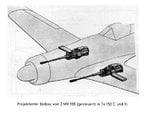- Thread starter
- #61
Shortround6
Lieutenant General
Thank you, choice of which Oerlikon or moving to the Hispano seems to depend on timing and perceived need. Might also depend on purchasing countries industrial state.
I would note that the Germans had a least two cannon they were trying out in the mid 30s and I have no idea when work started on the MG 151.
The RhB MG 204 was trial in a few aircraft and used a 20 x 105mm cartridge. The RhB MG C/30L was supposed to have trialed In Spain in a He 112 but as this was a lightened version of the standard 20mm AA gun using a 20 x 138mm cartidge it was large, heavy and slow firing. There are also claims that the MG 151/15 was trialed in Spain. Two years before it was installed in the He 115 float plane let alone the Bf 109F.
Adoption of the Oerlikon FF was to speed up development/get something into service before the German programs came to fruition?
I would note that the Germans had a least two cannon they were trying out in the mid 30s and I have no idea when work started on the MG 151.
The RhB MG 204 was trial in a few aircraft and used a 20 x 105mm cartridge. The RhB MG C/30L was supposed to have trialed In Spain in a He 112 but as this was a lightened version of the standard 20mm AA gun using a 20 x 138mm cartidge it was large, heavy and slow firing. There are also claims that the MG 151/15 was trialed in Spain. Two years before it was installed in the He 115 float plane let alone the Bf 109F.
Adoption of the Oerlikon FF was to speed up development/get something into service before the German programs came to fruition?

